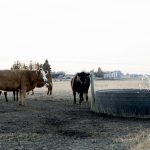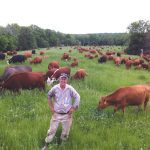
Grazing

Olds College researchers trial new technologies to support grazing and soil health
Satellite technology, soil biologicals and rising plate metres are all on the research docket at Olds College
Laio Silva Sobrinho’s passion is soil. He initially got his undergrad in forestry in Brazil, but when he came to Canada to do his master’s, he knew it would be in soil science. “Even during my undergrad, I worked with soil remediation in relation to heavy metals. So, it wasn’t too much of a change […] Read more

Manitoba beef producer focuses on rotational grazing on yearling operation
Longer rest period, daily moves and water infrastructure underpin Ryan Canart’s grazing system
Though Ryan Canart grew up in Kamloops, B.C., he has always had roots in Manitoba. He spent much of his time as a kid with cattle in sales barns with his brother and his father, who worked as an order buyer but was originally from Elkhorn, Man. He was comfortable around cattle at a young […] Read more

Hemlock: A deadly poison affecting spring and summer pasture
Vet Advice with Dr. Ron Clarke
Poisonous plants are a major cause of economic loss to the livestock industry. It’s estimated poisonous plants adversely affect three to five per cent of cattle, sheep and horses grazing the western range.

Transitioning yearlings to pasture
A well-planned and managed grazing season — focused on maximizing forage growth/production, adequate grazing management and appropriate mineral supplementation — can reduce production costs and increase profitability.

Native plant 411 for livestock producers
The native plants in your pasture tell a story about everything from disturbances to soil quality
Southwest of Calgary, Alta., as the jagged peaks of the Rockies level out to the Prairies, rough fescue grows in dense tufts. This native plant is Alberta’s provincial grass and a tasty meal for livestock in the fall and winter. Saskatchewan’s provincial grass is needle-and-thread grass, named after its sharp seed tip and long awn. […] Read more

Water systems for cattle operations
A water system can help beef producers make the best use possible of their resources
In Western Canada, the land aches for water. Drought has plagued parts of the Prairies for years now. Water levels in rivers, lakes and producers’ dugouts have dropped. Grass in the summer looks the same as it does in the fall — brown, crunchy and dead. The concern lingers going into the growing and calving […] Read more

Managing grazing through drought
Understanding how plants respond to drought is key to adapting your grazing strategy
I first met Dr. Alex Johnston, one of Canada’s leading range management scientists, at a 4-H camp that I was helping to lead in a wilderness area in the mountains north of Pincher Creek, Alta., many years ago. He was an impressive figure, dressed in his ceremonial headdress, given to him when he was inducted […] Read more

Finding a forage to fit your farm
What do you need to think about when you’re considering a cover crop or a perennial legume
Last summer, Canadian Cattlemen caught up with Graeme Finn, rancher and founder of Union Forage, at Ag in Motion. Here’s what he had to say about everything from cover crop blends to the “slow ponies” of the forage world — perennials. Know your soil “Before you even start down this journey with cover crops, know […] Read more

VIDEO: How to manage your grazing in times of drought
The Canadian Prairies have seen their unfair share of drought conditions for a number of years and that has made for challenging conditions for both cattle producers and the plant species they feed upon. Here, Dr. Breeanna Kelln, Assistant Professor at the University of Saskatchewan and Beef Industry Research Chair in Integrated Forage Management & […] Read more

Rotating to managed grazing
Rancher Greg Judy of Missouri explains why he switched from continuous to rotational grazing
Greg Judy’s farm in Rucker, Missouri, sounds picturesque: mild winters, flat land broken by rolling hills, dotted by livestock. “It’s not row cropland,” Judy says, speaking at the Western Canadian Conference on Soil Health and Grazing last winter. “It’s just basically rolling hills, very thin topsoil. And so what we’re dealing with there, folks, is […] Read more



